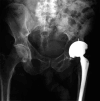Pelvic Pseudotumor Associated With a Ceramic Bearing Total Hip
- PMID: 38513193
- PMCID: PMC10959560
- DOI: 10.5435/JAAOSGlobal-D-23-00184
Pelvic Pseudotumor Associated With a Ceramic Bearing Total Hip
Abstract
Pseudotumors have been well documented to occur most frequently in metal-metal bearing total hip arthroplasties and less frequently in metal-polyethylene bearings. There are few cases in the literature of pseudotumors occurring in ceramic-ceramic articulations. We report a case of a large pelvic pseudotumor in a patient with a ceramic-ceramic bearing articulation in a 67-year-old man. In addition to the usual investigations, we did a detailed wear analysis of the ceramic implants and an examination of the soft tissues for particulate debris. The detailed wear analysis did show evidence of stripe wear; however, the volumetric wear was within the expected range. Synchrotron imaging identified strontium and zirconium debris arising from the ceramic surfaces. Although association does not mean causation, no other cause for the large pseudotumor could be identified and presumably represents an idiosyncratic reaction to ceramic debris.
Copyright © 2024 The Authors. Published by Wolters Kluwer Health, Inc. on behalf of the American Academy of Orthopaedic Surgeons.
Figures








References
-
- Harris WH, Schiller AL, Scholler JM, Freiberg RA, Scott R: Extensive localized bone resorption in the femur following total hip replacement. J Bone Joint Surg Am 1976;58:612-618. - PubMed
-
- Jacobs JJ, Urban RM, Hallab NJ, Skipor AK, Fischer A, Wimmer MA: Metal-on- metal bearing surfaces. J Am Acad Orthop Surg 2009;17:69-76. - PubMed
-
- Hayter CL, Gold SL, Koff MF, et al. : MRI findings in painful metal-on-metal hip arthroplasty. AJR Am J Roentgenol 2012;199:884-893. - PubMed
-
- Hauptfleisch J, Pandit H, Grammatopoulos G, Gill HS, Murray DW, Ostlere S: A MRI classification of periprosthetic soft tissue masses (pseudotumours) associated with metal-on-metal resurfacing hip arthroplasty. Skeletal Radiol 2012;41:149-155. - PubMed
-
- McGrory BJ, MacKenzie J, Babikian G: A high prevalence of corrosion at the head-neck taper with contemporary zimmer non-cemented femoral hip components. J Arthroplasty 2015;30:1265-1268. - PubMed
Publication types
MeSH terms
Substances
LinkOut - more resources
Full Text Sources
Medical

